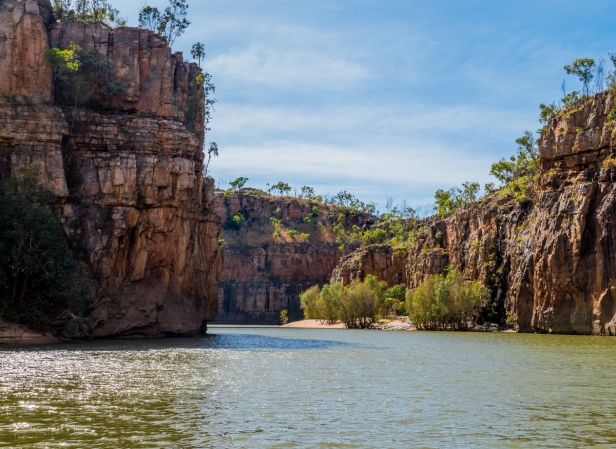
20-21 April 2015. It is time to stop. Driving south from Kakadu National Park we have reached the small town of Pine Creek and it’s time to stop for a break and a cup of coffee. Getting out of the car we immediately hear it: a continuous kind of screeching squealing noise. What is that? A fleeting thought that it’s birds is quickly dismissed. Following the noise across the road to a small park we look up into one of the trees and our jaws drop. The tree is jam-packed with bats! Hundreds of them. And the tree next to it, and the one next to that. Hundreds of squealing fruit bats, or flying foxes, as they are more accurately known. We watch them for a while, captivated.
I’d forgotten about the bats, and the noise they make. I’d seen them a few years earlier, trees full of them, in the Botanical Gardens in Sydney. And years before that when I lived in the desert town of Dampier in Australia’s far northwest. Walking out in the cool nighttime air we’d frequently see them flying overhead. They are about the size of squirrels, and they pollinate and disperse the seeds of many native plants. Even in daylight hours they are restless. At night they really come alive.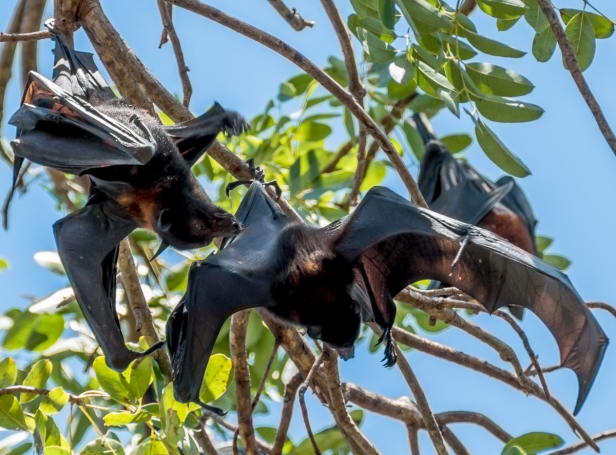
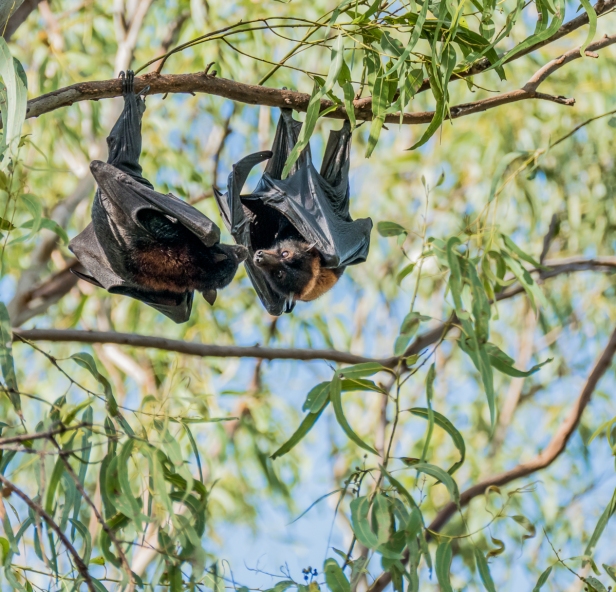

Travelling anywhere in the far north it’s impossible to avoid the road trains, an iconic symbol of Australia’s vast empty land, and an efficient means of freight transportation.
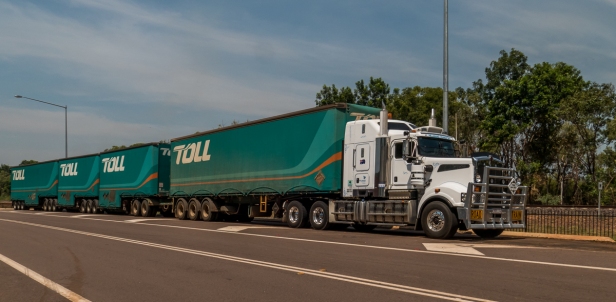
These two are only four ‘carriages’ long, though we saw five a few times, and one train with six. They are used to transport goods from the south to the remote towns of the inland desert and the far north. They are also used to transport cattle from remote cattle stations to market, and ore from equally remote mines. They are banned on most roads in the populated southern and eastern states. All of northern outback Australia relies on the road trains with ore, cattle and fuel, along with general freight, being the most common loads. They are over fifty metres long, and can weigh up to two hundred tons. They can’t slow down in a hurry, they can’t turn in a hurry, and they definitely can’t stop in a hurry. We keep well out of their way.
Travelling south from Pine Creek we come to the town of Mataranka. Mataranka thermal pool is a little slice of outback luxury where we float off the dust of the drive in crystal clear emerald green warm water. The pool is spring fed and the water is about 34 degrees centigrade. Gentle dappled sunlight filtered by the surrounding paperbark and palm forest dances on the water. We feel as if we’ve wandered into bliss. Unknown to us there is even better to come just down the road at Bitter Springs.
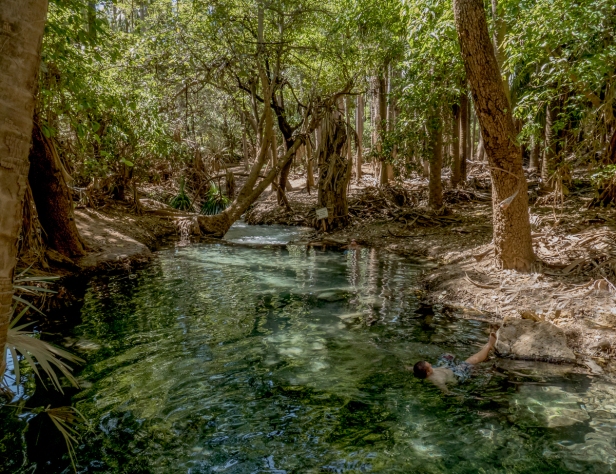
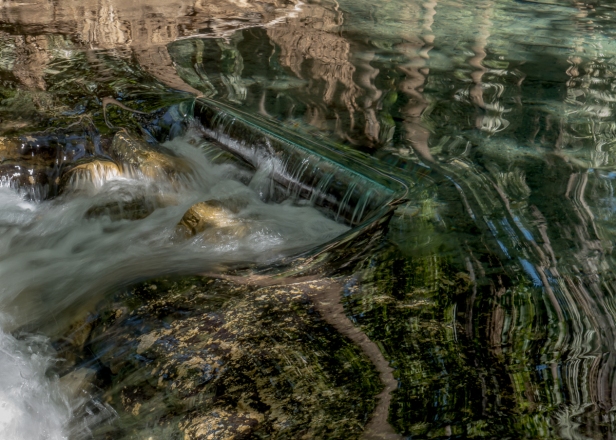
After our soak in the pool we decide to go for a walk along one of the many trails in the area. Since it’s the end of the wet season, much of the land is still flooded,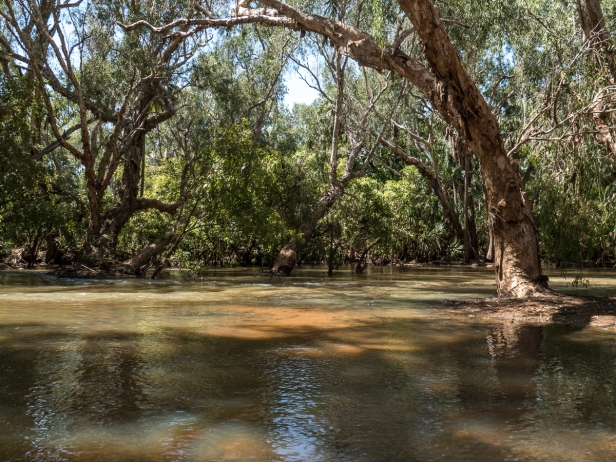
and the Roper River, normally gently flowing, has spilled its banks and rushes forward in disarray, all over the land.
For a while the trail is clear but we soon find ourselves wading through water, always on the lookout for crocodiles. It feels to me much like hiking in Canada. In Australia’s north it’s crocodiles, in Canada it’s bears. There’s always something that could leap out and get you: it’s great to be out hiking, but we never quite relax. Anyway, finally we decide we’ve crossed sufficient stretches of wayward water and have gone far enough. Instead of going on to complete the trail loop we return the way we came, eventually getting back to higher ground.
From Mataranka we drive the short distance to Bitter Springs. The only reason we know about Mataranka is because my sister had been there years before and told us about it. It is not one of the main tourist destinations in the Northern Territory in the way that Kakadu National park is. And it is only after arriving in Mataranka that we find out about Bitter Springs. We have no idea what to expect except that we know it is another thermal pool in the area. We are greeted with a natural fairyland: a river of sparkling emerald thermal water surrounded by a pretty forest of gums and palms, sunlight flickering through the leaves, dragonflies dancing on the lilies.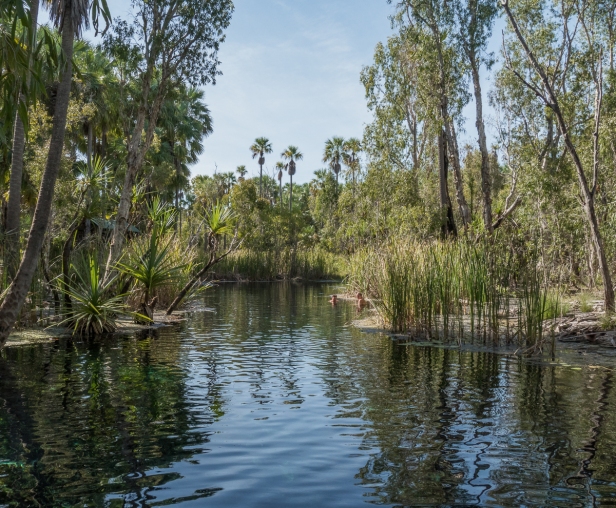
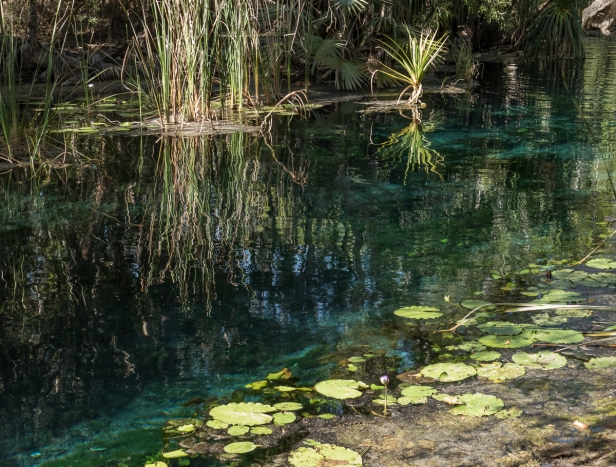
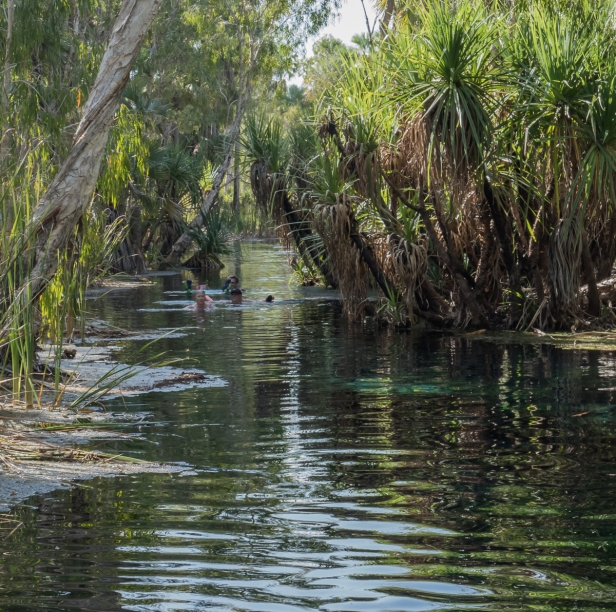
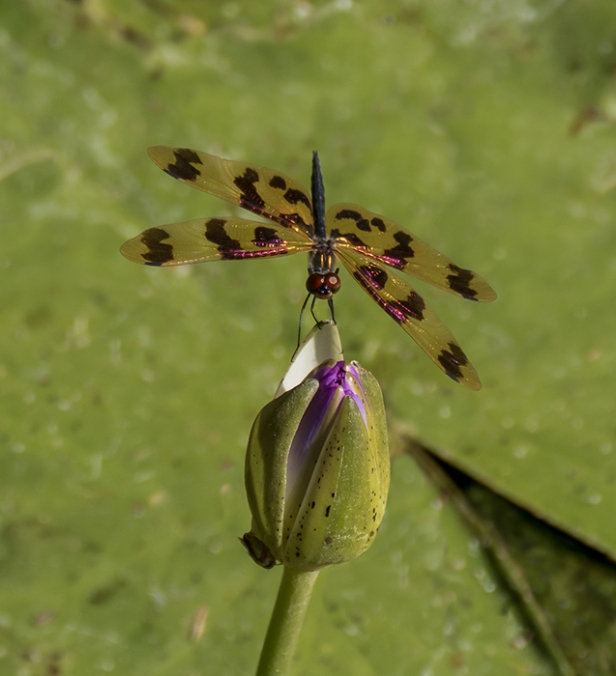
There are a few other people there, though it is far from crowded. Some are on the shore near stairs leading into the river, some laze in the water holding onto the stair railing to keep from being pulled downstream. It’s a thermal pool that is also a flowing river. The place to float is about one hundred metres long with an exit point at a small bridge. Like Mataranka thermal pool the water is crystalline, and like a warm bath. A fellow visitor lends me a pool noodle, which really helps. With a noodle, or other flotation device it’s possible to really let go and let the water carry you along. Starting at one end we float gently downstream. It is another slice of paradise.
Family fun,
and pure relaxed bliss. She has her crocs, the safe plastic kind, hooked around the ends of the pool noodle for the walk back.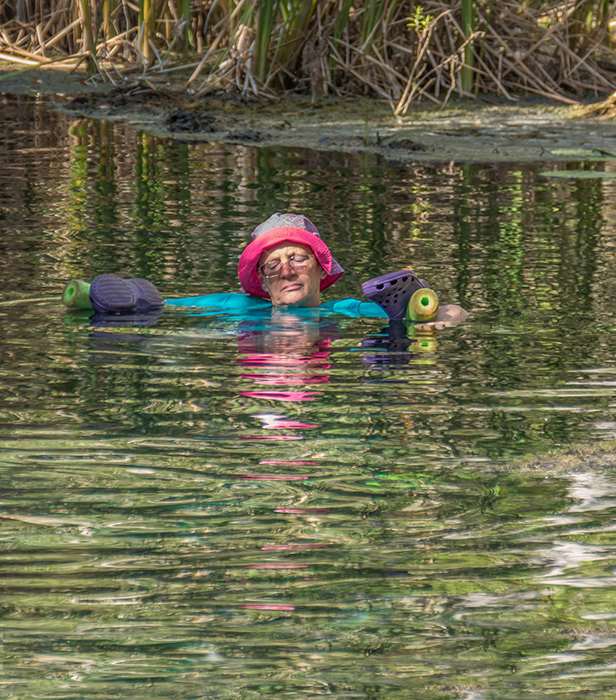
22 April 2015. Walking from the Nitmiluk Visitors’ Centre down to the dock at Katherine River I hear it again, that screeching squealing noise. I immediately look up into the tall trees and there they are, the flying foxes, hundreds of them. I watch them for a while and as I’m focused on photographing them I suddenly hear a loud thud. Not three metres from where I’m standing a python has fallen out of the tree wrapped around one of the bats. I watch as the python strangles and begins to consume the bat, its jaw stretching wide enough to encompass it, the bat silent, no doubt suffocated by now. Nature in the raw. I am shocked. And fascinated. I have no fear. The python has no interest in anything other than its meal.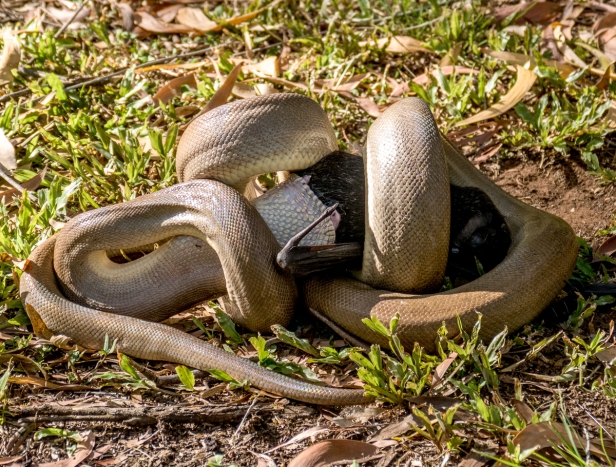
Don, having lost interest in looking at the bats, had wandered away. I join him at the dock and we embark on a cruise through Katherine Gorge in Nitmiluk National Park.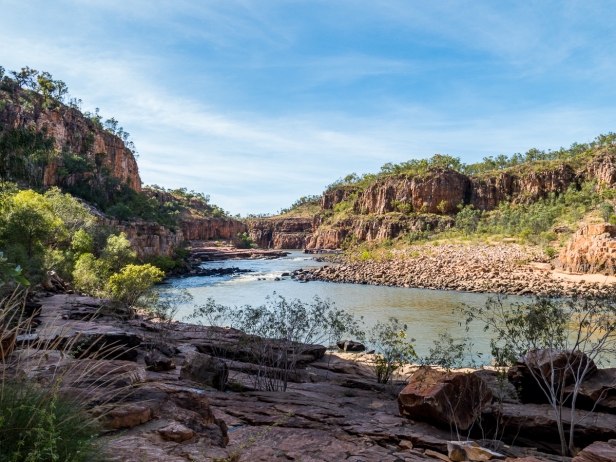
For four hours we travel down the river through the gorge. The land is rugged, imposing. It bears down on you with an ancient force. The gorge is twelve kilometres long, most of the sheer rock cliffs more than seventy metres high. There are in total thirteen gorges creating a maze of waterways sculpted from sandstone over millennia.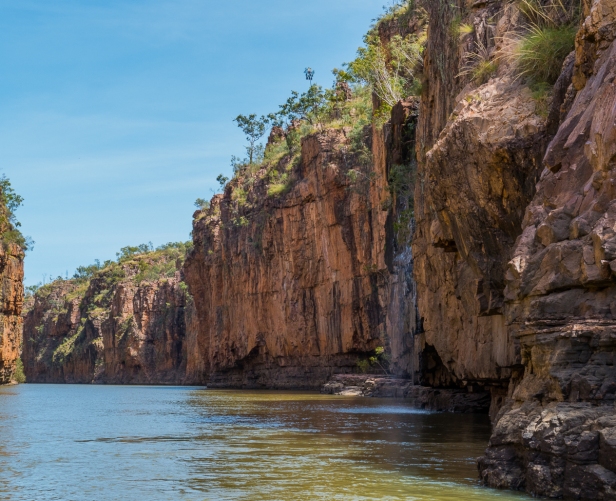
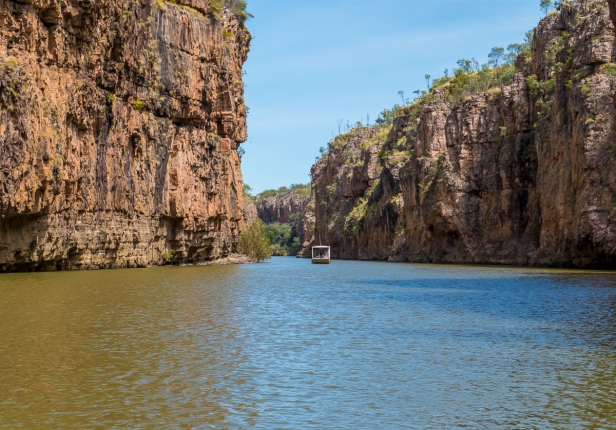
This is Jawoyn country. We stop to look at rock art that is forty-five thousand years old. The Jawoyn lived here until the pastoralists came in the 1800’s and claimed all the land. The first land claim by the Jawoyn People in 1978 was rejected. They were later able to take the ministers responsible on a tour of their land showing them all they knew about it: the location of rock art and sacred sites, and their knowledge of the land and its plants and animals, to prove it was originally their land. Finally after an eleven-year struggle they won their land claim in 1989. They then leased it back to the government to create a National Park with the motto “Sharing Our Land”. I am moved to tears that they could be so generous after all that has been done to them: the displacement, the lack of respect, the loss of dignity and their way of life, but it is an elegant solution in which everyone benefits. The sole tour operator in the park is owned by the Jawoyn People. The town and the river were both named Katherine by an early explorer in the late 1800’s. After the Jawoyn regained title to the land it reverted to their original name for it – Nitmiluk, meaning ‘cicada place’. Nit nit is the sound the cicadas sing hiding in the grass on hot summer evenings.
Continuing down the river we pass numerous small sandy beaches at the bottom of the cliffs, cliffs that look as is they’ll fall down on top of you, a few tall thin waterfalls, and crocodiles.
Eventually we come to some rapids and can go no further. It’s time to hike – past young Mataranka palms outlined against the sky,
past shimmering lily ponds,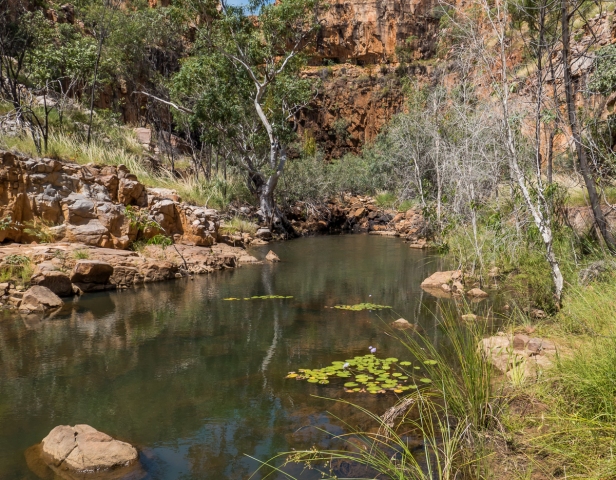
through dry grasses, sometimes clambering over rocky ground, eventually arriving at Lily Pond Falls,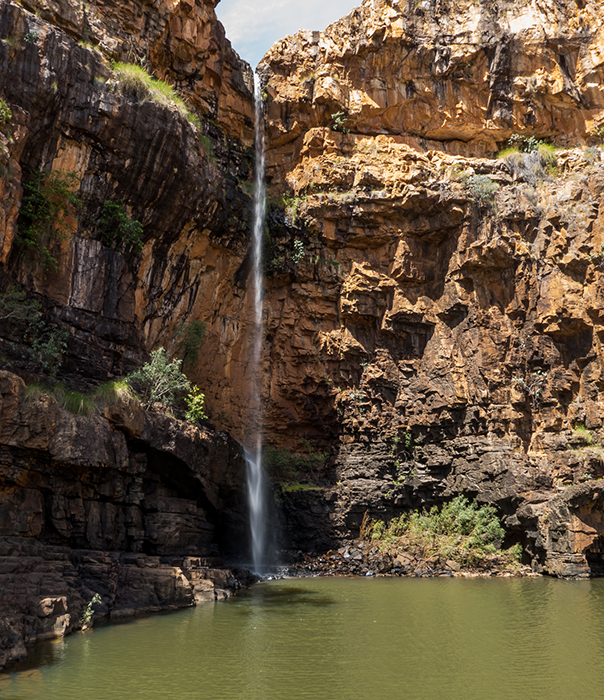
and yet another swim in yet another beautiful un-crowded isolated crocodile-free plunge pool. We are surrounded by cool soothing waters and red dragonflies.
Returning from our cruise we stop for coffee at the visitors’ centre. It appears that the blue-faced honeyeaters have long ago figured out that the terrace of the visitors’ centre is a great place to cadge a meal. There are at least half a dozen of them flying around, peering down from the rafters, landing on tables or the backs of chairs, on the alert for a safe moment to grab an abandoned crumb or a piece of sausage or pie, or, in my case, get their greedy beaks into my coffee cream.
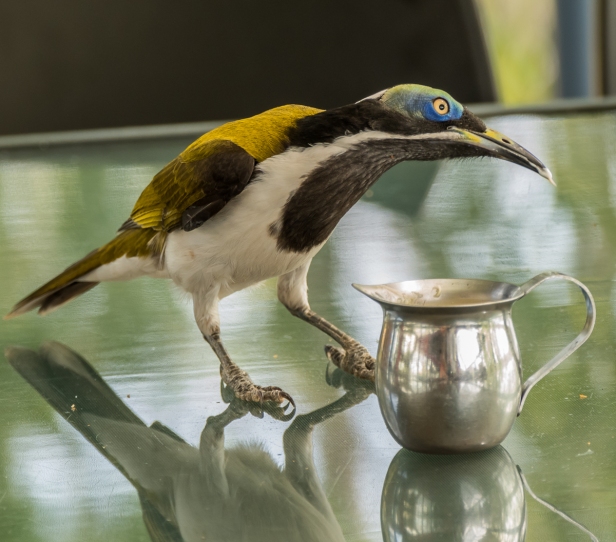

Walking a short distance from the visitors’ centre we see several wallabies grazing peacefully, unconcerned by our presence.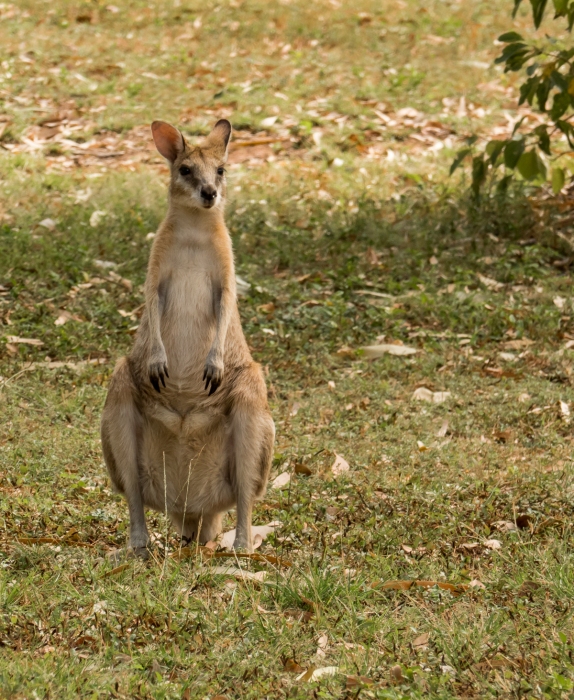

Wildlife count for the day: six wallabies, two crocodiles, several red-bodied dragonflies, thousands of fruit bats, one python, and half a dozen blue-faced honeyeaters who stole my coffee cream.
Next post: Oh yes – more about crocodiles: the best croc story yet! Magnetic anthills that point north-south, a fishing monitor lizard, the bubbling waters of Litchfield National Park, and Darwin’s beautiful Mindil Beach.
All words and images by Alison Louise Armstrong unless otherwise noted
© Alison Louise Armstrong and Adventures in Wonderland – a pilgrimage of the heart, 2010-2015.

As usual awesome photos.
LikeLiked by 1 person
Thanks so much Pam. Hope to see you soon. We’ll be in San Miguel Jan through May – there must be a visit in there somewhere!
Alison
LikeLike
Heart the dragonflies! Especially that first one. How clever he is to sit on a flower that brings out his best features!
LikeLiked by 1 person
Aren’t they wonderful. What I loved most about them is they sat still long enough for me to photograph them!
Alison
LikeLike
Wow!
LikeLike
Thanks. It’s definitely a wow kind of place!
Alison
LikeLiked by 1 person
Amazing place, photos and BATS!!! Love them!
LikeLiked by 1 person
Thanks Cindy. Yes it is an amazing place. We’re so glad we went to the Top End. I loved the bats too. I especially loved the python with its bat – nothing quite like seeing the raw truth of nature at work up close like that. It was fascinating and shocking at the same time.
Alison
LikeLike
Absolute magic, Alison. I’m ashamed to say that in the 3 1/2 years we lived up there we didn’t see anywhere near as much as you and Don have and I didn’t know about Bitter Springs. Just loved the photos and will be looking at them a number of times.
LikeLiked by 1 person
Thanks Ros, I’m so glad you enjoyed it. We had an amazing time in the Top End, and it’s always easier to get around and explore a place when you don’t live there. We were lucky to find Bitter Springs. It was a real treat.
Alison
LikeLike
Love the pics.. What awesome places.. So beautiful and picturesque.. Love the close up pics of the bats too.. 😊👍👍👍
LikeLiked by 1 person
Thanks Neethu. Yes, awesome places. We were thrilled. And completely shocked by the bats – I’d forgotten that I’d seen them a few years earlier in Sydney. They’re quite loud, and there are hundreds in each tree.
Alison
LikeLiked by 1 person
Wow it’s amazing and spooky at the Same time.. 👍
LikeLiked by 1 person
wow – great landscape and great adventures!! I would love to be there now!! 🙂
LikeLiked by 1 person
Thank you so much. It’s an amazing part of the world. We’re so glad we went there. I highly recommend it!
Alison
LikeLike
Super again, Alison and Don. What a rewarding area to visit. Onward… watching for crocs Keith
LikeLiked by 1 person
Thanks Keith. It was a very rewarding visit. You never knew what was going to fall out of the tree you were standing next to! Yes, one more croc story to come. They, or the threat of them, were always near.
Alison
LikeLike
Nice Photographs, nice view…really enjoyed and felt like going there….!!!
LikeLiked by 1 person
Thanks Madhu. I really recommend visiting this part of the world – it’s quite amazing.
Alison
LikeLike
Amazing wildlife viewing – and what colors and drama (that bat! that python!)
LikeLiked by 1 person
It was as fabulous as we could have hoped for. That python was so completely unexpected! Birds and kangaroos are pretty much guaranteed, but the python was an extra bonus that’s for sure.
Alison
LikeLike
Isn’t mother nature wonderful? (even those bats, which have never looked quite so Halloweeny to me before)
LikeLiked by 1 person
We are huge fans of Mother Nature! Truly wonderful, especially when you can get really close. It was fascinating watching the bats. I remember in Sydney when I saw them they were in much taller trees. This time they were relatively close. I had no idea they were so restless. Some were sleeping but most were moving around. And the python was the icing on the cake. I think we won the wildlife count for the day!
Alison
LikeLiked by 1 person
Alison – If you ever get to Austin, Texas, they have a nearly-domesticated bat settlement that people gather to watch nightly as the bats fly out. Such fun.
LikeLiked by 1 person
Of course, your bat, python, crocodile, dragonfly, and usual glorious bird photos were stunning, but the creatures I was most transfixed by were the … road trains! I’ve never seen or heard of such things, and they were amazing beasts to see! And where do you get your photographer’s luck? A python (otherwise occupied, no less) drops at your feet, and those four honeyeaters arrayed themselves just perfectly for your shot! (I’m actually quite sure it’s not luck; it’s patience and instinct and talent, and you’ve got them all!)
LikeLiked by 1 person
Thank you so much lexklein. I knew of road trains, being Australian, but can’t remember if I’d actually ever seen them before except in pictures. They’re pretty amazing aren’t they?! And they’re all over the outback (Aussie for the largely uninhabited centre of the country). As for my photographer’s luck, I do think a lot of it is just that. The python was of course completely unexpected and shocking and brilliant. I must admit that as soon as we realised the honeyeaters were after the jug of cream we moved it to an unoccupied table and stood back a little. They all just honed in on it. There is some patience involved of course, but I was immediately aware of their reflections in the glass table and how beautiful it looked so tried to include as much as I could – so there’s something in that about what I see. I’ve always been a visual person from very young. I take innumerable photos that are garbage. Praise the Lord for digital photography – I just keep clicking until I get the shot I want.
Alison
LikeLiked by 1 person
I love bats. And snakes. And all these years of loving and observing both, I’ve never seen this happen. That being said, I’ve never seen pythons in their natural habitat. Anyhow, way cool!
LikeLiked by 1 person
Thanks Bela. It is unusual to come across someone who loves bats and snakes! I can’t say I do, though neither am I repelled by, or afraid of them. It was a fabulous experience when the python dropped out of the tree – really exciting. It was definitely way cool!
Alison
LikeLiked by 1 person
Nice!
LikeLiked by 1 person
OK…I would like to order one of your coffee books right now. You’re like the dragonfly conjurer. The bird conjurer. And now, the road train conjurer. That croc photo is luscious. Was he just sufficiently in the sun, or did you have to LR him into the light? Let me get this right…you’re standing there and a python with a bat in his mouth falls to the ground right beside you? And I thought I was taking up too many travel miracles!!
LikeLiked by 1 person
As soon as the coffee table book exists I’ll let you know 🙂
I guess I took road trains for granted, having grown up in Oz. I’d never actually seen one before that I can remember, but I definitely knew about them. Of course I wanted to get the iconic picture of one in the red desert at sunset, but it was not to be.
Ha. Birds and dragon flies are easy 🙂 Apparently all you need for honeyeaters is a small jug of cream. That was unexpected.
Actually I was in dragonfly heaven in the Top End because they are the first dragonflies I’ve come across that stay still long enough to be photographed. I’ve never been able to catch one in Canada. I’m being facetious about photographing birds. They are really hard to get and I miss far more often than not.
And yes, you got it right – I was standing there and a python with a bat in his mouth falls to the ground right next to me! It was like a miracle from heaven. Talk about being in the right place at the right time!
I believe there is not actually a limit on the number of miracles, travel or otherwise. Have as many as you want!
I don’t know if you read it of not but I wrote a whole post on miracles:
And there’s a little miracle about coming across an Andean wolf, who showed no hurry to run away, right by the side of the road, in this post:
As for the crocodile. I’m sure I would have adjusted light and shadow in LR, but basically he was sufficiently in the sun to get the shot.
Alison
LikeLike
Each day looks more perfect than the last surrounded by nature’s beauty and magical creatures. Your photos of the bats, the blue-faced honeyeaters and dragonflies are amazing but my favorite is of the woman floating in perfect relaxation with the noodle and her crocs attached! Anita
LikeLiked by 1 person
Thanks Anita. I love that photo of the woman floating too – the epitome of total relaxed bliss. I did send it to her. We loved Bitter Springs. It is not that well known, uncrowded, the water is thermal spring fed so it’s really warm, and it’s a completely natural setting. Glorious. Pretty much every day in the far north was fabulous – definitely a highlight of our travels.
Alison
LikeLike
I am not sure what is crazier – those bats or this road trains. I’d be seriously terrified to see one of those trucks on the highway. That area looks so beautiful, sort of like the SW USA.
LikeLiked by 1 person
Both are pretty crazy. I knew about the road trains but it was amazing to actually be on the roads with them. We learned to be very respectful of them! And they’re clearly marked so if you’re behind one and want to pass you know you need a very long distance to do it. I was dumfounded by the bats. There is really no way to describe looking up into a tree packed with hundreds of squealing restless bats the size of full-grown squirrels. Good thing they have the claws needed to hang on tight. It never occurred to me that one would fall out of the tree on to me. They sleep hanging upside down so you have to figure their claws are strong enough. The python on the other hand was another story.
The whole area of the far north is very beautiful, especially at the end of the wet season when everything is green and lush. We’re really glad we went there.
Alison
LikeLike
Loved this post! I encountered fruit bats in Australia years ago (volunteering to study them and their environment, i.e counting fig trees!) in Cape Tribulation. Had to feed some by hand that had been rescued and were protected from snakes by netting.They’re such beautiful, foxy, curious creatures… peering into your face, pulling your hair. It’s a wonderful reminder when I look at your amazing photos. And would really like to go to those thermal pools!!
LikeLiked by 1 person
Thanks Amanda. It must have been amazing to work with the bats like that, up close and personal. They have really cute faces. Those thermal pools are definitely worth a visit!
Alison
LikeLike
Hi Alison, this is an amazing post! What an adventure! Gorgeous photos! I am most moved by the story of the people who fought to get their land back, and then donated it to become a park.
LikeLiked by 1 person
Thanks so much Naomi. Our whole two weeks in the Top End was an amazing adventure. I’m so glad we went. It stands out as a highlight that’s for sure. It was heartening to hear some of the stories of the Aboriginal people while we were up there. They have a much stronger presence in the north than in the rest of Australia. Kakadu National Park is partially owned by the Aboriginal people and Arnhem Land is a huge reserve where they still teach and live the traditional ways. The Aborigines in the north have some wealth now due to owning the tourist ventures, but throughout the country land claims still have a long way to go, and I think there is still a lot of racism in the more populated south. I too was moved by their story.
Alison
LikeLiked by 1 person
beautifully
moving
adventure 🙂
LikeLiked by 1 person
Thank you for
venturing along
the waterways
with us.
Alison
LikeLiked by 1 person
Beautiful descriptions and images, Alison! Places like Katherine Gorge that are so clearly the product of millions of years of geological processes are amazing to discover. Comparing such ancient lands with the glass and steel canyons of our modern cities reminds me just how much our human experience has transformed. It is so astounding to contemplate…
I think a python dropping out of the sky with a bat in its grasp would have been the last straw after keeping my eyes peeled for crocodiles all day… I wonder how such an event would have been interpreted by the Jawoyn? (…it’s going to rain in a fortnight!? …be home by 5? …stop lazing about all day and learn to hunt?)
Peace
Michael
LikeLiked by 1 person
Thank you so much Michael. It would be wonderful to be able to time travel to see the world before it was transformed into the cities and towns of today – glorious and powerful and magical as it still is when you get right into what true wilderness is left.
The python! Now that was a special magical moment. No matter the transformation we have concocted on this earth there is still nature in the raw going about its business as it has for eons. I interpret that event as a miracle – that I was there in the right place at the right time to witness such a thing. As for the Jawoyn, I cannot say.
Alison xox
LikeLiked by 1 person
It’s hard to know what’s coming next. Your photos and story telling are compelling! 🙂 My absolute favourites are the last shot of the spa pool ((totally delicious!) and that incredible dragonfly on the flower. But the lady dozing in the pool had me smiling, too 🙂
LikeLiked by 1 person
Thank you so much Jo. I really appreciate your compliment. Sometimes writing the stories feels like hard work. I like the lady dozing in the river – it really expresses how it is there. And I was thrilled with the dragonfly photo. The last spa shot – you mean the one of the mini waterfall at Mataranka? I only included that because I love it as a photo, I love that I captured the light and the movement.
Alison
LikeLike
Yes- it’s perfection for a water lover 🙂
LikeLiked by 1 person
Wow what a trip! The bats were a little scary though. I am not a big fan of bats especially so many of them in a tree! Love all the birds and nature. It looks like a lovely place Alison!
LikeLiked by 1 person
Our whole trip through the ‘Top End’ of Australia was amazing. We’re so glad we went there. It is indeed a beautiful place. Bats don’t fall out of trees, unless a python has gotten a hold of one of them 🙂
Alison
LikeLike
My first thought about Mataranka was “hurray – no crocs!” I’m so glad to hear that there are lovely hot springs where crocs won’t try to eat you. And I really want to float down the river/hot spring. Given the cold wind and November rain lashing these UK windows, that sounds like heaven!
LikeLiked by 1 person
We were also delighted there were no crocs at the thermal pools (except the plastic kind). They were both beautiful, special places. We were lucky to be there in the off season so no crowds. We’re in Van and although it’s sunny today it’s cold and we’ve seen plenty of rain – memories of Bitter Creek warms me up. UK in winter brrrrr!
Alison
LikeLike
Amazing pics!
LikeLiked by 1 person
Thank you so much 🙂
Alison
LikeLiked by 1 person
Reading your posts is just like being there!
LikeLiked by 1 person
Thanks Darlene. That’s such a wonderful compliment – really encouraging!
Alison
LikeLike
Wonderful post.So heartening to know about the Jawoyn people.Looking forward to more hair raising encounters.Cheers.
LikeLiked by 1 person
Thanks so much Sidran. I was pleased to hear about the Jawoyn people too. It was wonderful to hear a good news story for a change.
Alison
LikeLiked by 1 person
Amazing adventures you two get up to, talking about being in the right place at the right time? Catching that moment of the pythom and the bat must have been quite a surprise. The nature all around the hot springs look so lush it must have been so relaxing to float there and whatch the wild life and plants. Did you manage to see all that you wanted to see in North?
LikeLiked by 1 person
The whole of our time in the far north was a fabulous adventure. We’re so glad we went, and yes, we did manage to see all we wanted, although there’s always more isn’t there?! The hot springs were absolutely wonderful, and a bit of a bonus since I doubt we’d have thought of them, or even known about them, if my sister hadn’t been there years before. And the python was just one of those travel miracles!
Alison
LikeLike
oh those honey eaters love the reflections….love this too…❤️
LikeLiked by 1 person
Aren’t they gorgeous?! It was so much fun that they came to visit and that we had plenty of time to photograph them, and to just watch them. Very sweet.
Alison
LikeLiked by 1 person
Absolutely stunning pictures! In love with the attractive and picturesque location. Close up shots of the bats are truly mesmerizing. Thanks for introducing us to such an amazing place. Since I love wildlife, soon will plan a trip here with my family.
LikeLiked by 1 person
Thank you so much Zoey. The northern part of Australia’s Northern Territory is a very special and unique part of the world, and definitely worth visiting.
Alison
LikeLike
Reblogged this on Cristian Mihai.
LikeLiked by 1 person
What an amazing adventure you had in the north. And such stunning photos. We’re hoping to do the big trip in the next year or so but time will tell. In the meantime, thanks for sharing and allowing us to live it through your images.
LikeLiked by 1 person
Hi Miriam. Thanks for your lovely comment. And you’re welcome. It *was* an amazing adventure – one of the highlights of all our travels. We’re so glad we went there. If you search Top End on the blog you’ll find my other posts about it.
Alison
LikeLiked by 1 person
Thanks Alison, I’ll check them out at some stage.
LikeLiked by 1 person
What a journey! Thank you for taking me there by photographs. It was an amazing experience.
LikeLiked by 1 person
Reblogged this on quirkywritingcorner and commented:
gorgeous photos
LikeLiked by 1 person
Thank you! Much appreciated.
Alison
LikeLike